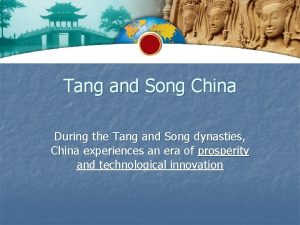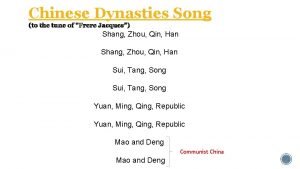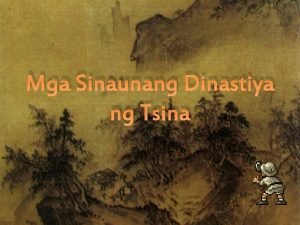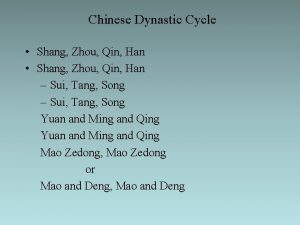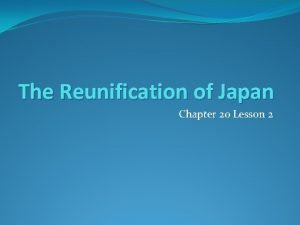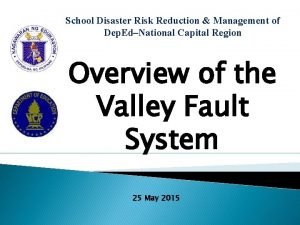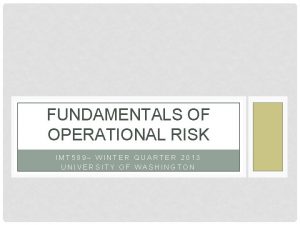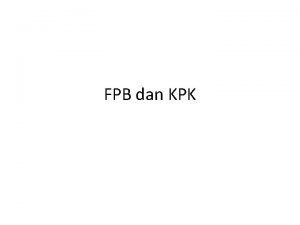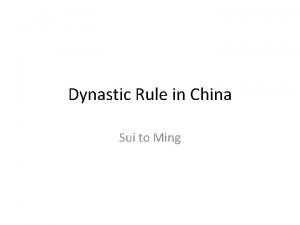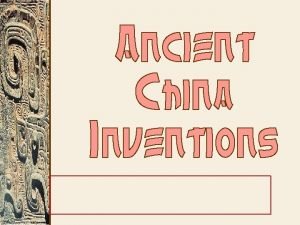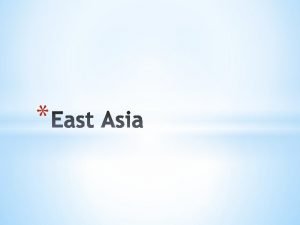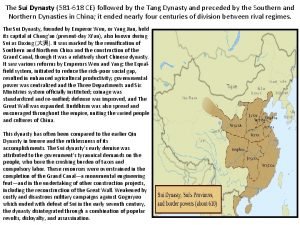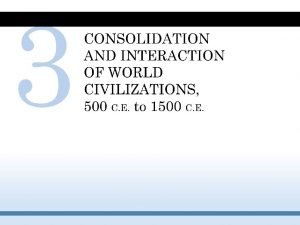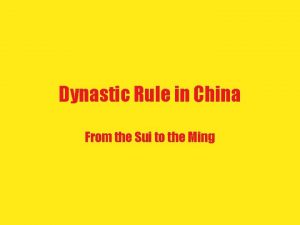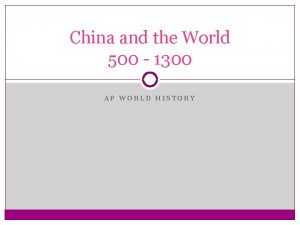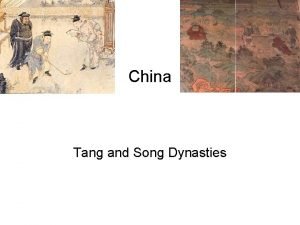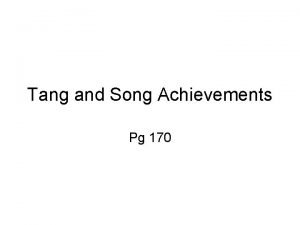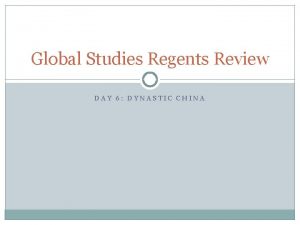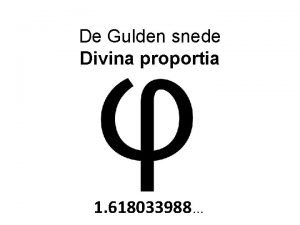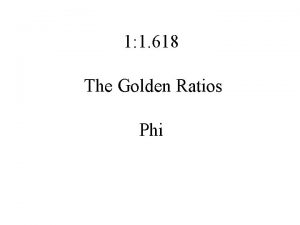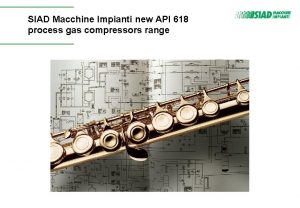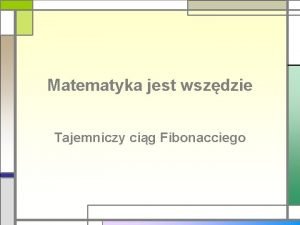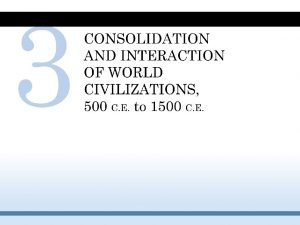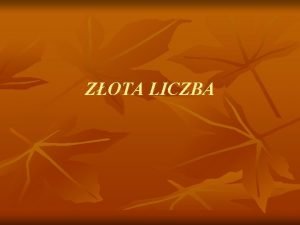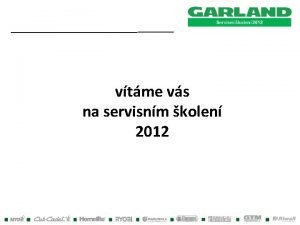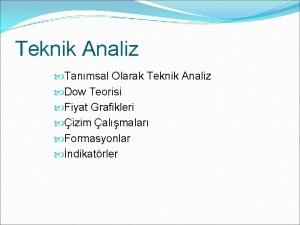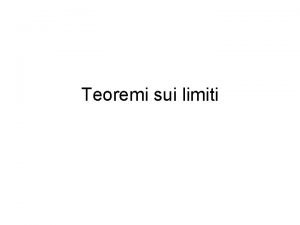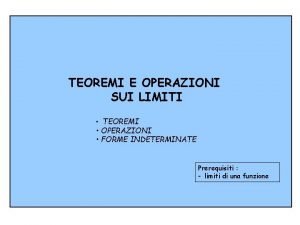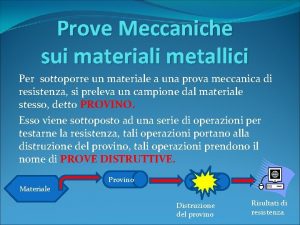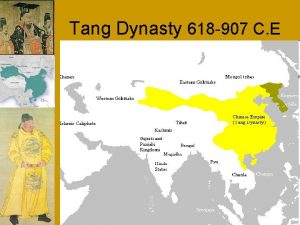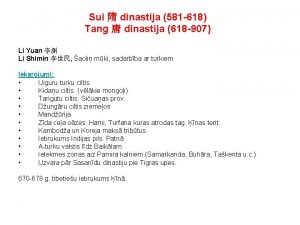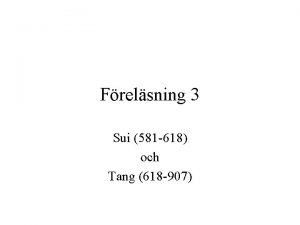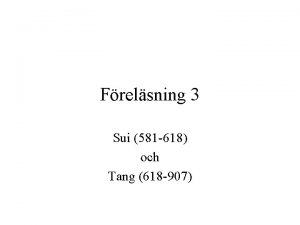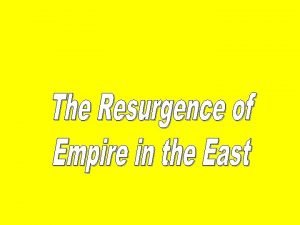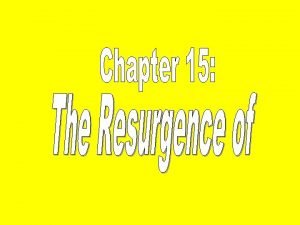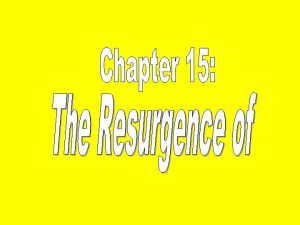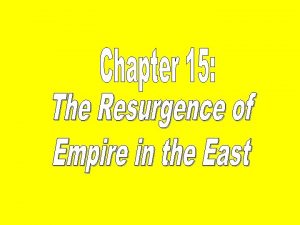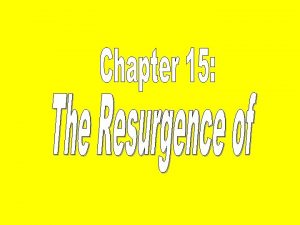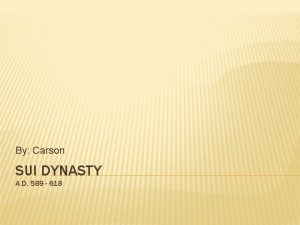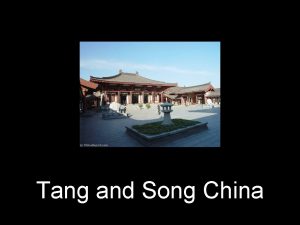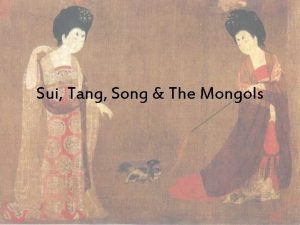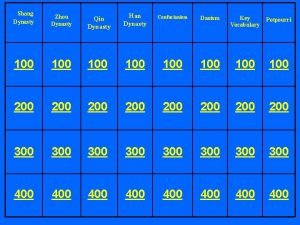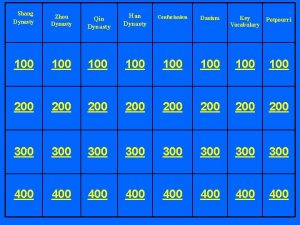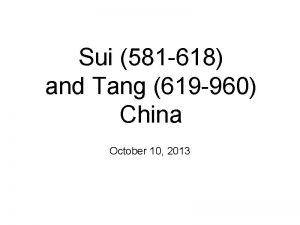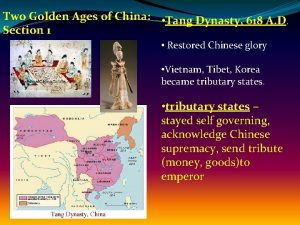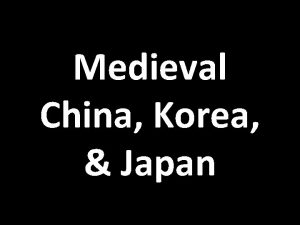Introduction Sui Dynasty 589 618 Reunification Tang Dynasty

















































- Slides: 49




Introduction Sui Dynasty 589 -618 Reunification Tang Dynasty 618 -907 High point in poetry Influenced Japan, Korea, Vietnam Song Dynasty 960 -1279 Most brilliant age in philosophy since Zhou Yuan Dynasty 1279 -1368 Empire Copyright © 2009 Pearson Education, Inc. , Upper Saddle River, NJ 07458. All rights reserved.

Move to Reunification After confusion of Six Dynasties period Push for re-creation of centralized bureaucratic empire modeled on earlier Han state First steps taken by Northern Wei 386 -534 Northern Sino-Turkic state Moved court to Luoyang Made Chinese the language of the court Adopted Chinese dress and surnames Imposed new land tax Copyright © 2009 Pearson Education, Inc. , Upper Saddle River, NJ 07458. All rights reserved.

Sui Dynasty 589 -618 Sui Wendi - d. 605 General of mixed Chinese-Turkish ancestry Unification and reestablishment of centralized bureaucratic government Great Wall rebuilt Grand Canal constructed Linked Yellow and Yangtze Rivers Similar to earlier Qin Short-lived military dynasties restored order Copyright © 2009 Pearson Education, Inc. , Upper Saddle River, NJ 07458. All rights reserved.

Tang Dynasty 618 -907 First Tang emperor - former Sui provincial governor Retook Sui capital and renamed it Chang’an Emperor reconciled conflicting sets of interests Bureaucratic government centralized under him Concessions to the aristocrats • • Tax system “Equal field system” Exemptions Aristocrats as high officials Copyright © 2009 Pearson Education, Inc. , Upper Saddle River, NJ 07458. All rights reserved.

Governmental Structure Organization under three organs Military Affairs - supervised armies Censorate - watchdog functions Council of State - met daily with emperor • Secretariat - drafted policies • Chancellery - reviewed policies • State Affairs - carried out policies s Six Ministries - core of central government Copyright © 2009 Pearson Education, Inc. , Upper Saddle River, NJ 07458. All rights reserved.


Empress Wu 626 -706 Originally concubine for the second emperor Became empress of third Tang emperor Poisoned or eliminated all rivals Regent for her son for seven years Deposed him and ruled as emperor herself Only woman in Chinese history to hold title Moved court to Luoyang Fervent Buddhist and built temples Scholars of the North Gate Copyright © 2009 Pearson Education, Inc. , Upper Saddle River, NJ 07458. All rights reserved.


Chang’an of Xuan-Zong - r. 713 -756 Reformed government finances Grand Canal repaired New census Splendor of Chang’an Population of one million Trading center Great walls enclosed thirty square miles Copyright © 2009 Pearson Education, Inc. , Upper Saddle River, NJ 07458. All rights reserved.


Tang Empire Territorial expansion and contraction Threats from Tibetans, Turks, Mongols Four tier policy to protect borders Sent armies if all else failed Alliances with nomads against nomads Border defense, including Great Wall Bring enemy into empire as tributary state • Significance of embassies • Access to Tang culture and technology Copyright © 2009 Pearson Education, Inc. , Upper Saddle River, NJ 07458. All rights reserved.


Rebellion and Decline Problems with Manchurians, Tibetans, Arabs An Lushan Rebellion Order restored with aid of Uighur Turks Land reform Equal field system eliminated Replaced with fixed quota on each province More wars Bandits and warlords Collapse in 907 Copyright © 2009 Pearson Education, Inc. , Upper Saddle River, NJ 07458. All rights reserved.

Tang Culture Cosmopolitan because of its openness Flow of Indian art and philosophies Widespread commercial contacts New religions - Nestorian Christianity, Zoroastrianism, Manichaeism, Judaism, Islam Central Asian music and musical instruments Golden age of Buddhism in China Spread of temples and monasteries Temples served as schools, inns, bathhouses Copyright © 2009 Pearson Education, Inc. , Upper Saddle River, NJ 07458. All rights reserved.



Buddhist Sects Tiantai sect was principal in early Tang Maitreya - a Buddha of the future Will appear and create a paradise on earth Amitabha - Lord of the Pure Land Salvation by reliance on Amitabha Chan (Zen in Japan) Buddha was a human teacher Enlightenment by each individual’s efforts Regimen of physical labor and meditation Copyright © 2009 Pearson Education, Inc. , Upper Saddle River, NJ 07458. All rights reserved.

Secular Scholarship Tang culture marked the reappearance of secular scholarship and letters Scholarly-bureaucratic complex emerged Expansive production of poetry Official history of the previous dynasty Compilation of dictionaries Commentaries on Confucian classics Ghost stories and tales of adventures Copyright © 2009 Pearson Education, Inc. , Upper Saddle River, NJ 07458. All rights reserved.


Li Bo - 701 -762 Un-Buddhist, Daoist? Swordsman and carouser “Bring on the Wine” “Drinking Alone in the Moonlight” Poetry is clear, powerful, passionate Sensitive to beauty Sense of fantasy Life is brief and universe is large Along with Du Fu - greatest poets Copyright © 2009 Pearson Education, Inc. , Upper Saddle River, NJ 07458. All rights reserved.


Du Fu - 712 -770 Un-Buddhist, Stoic in nature? Friend of Li Bo Life of hardship Failed metropolitan exams, poverty Captured by An Lushan rebels Poetry is less lyrical and more allusive than Li Bo More compassion for human suffering Humans are short-lived and nature endures Copyright © 2009 Pearson Education, Inc. , Upper Saddle River, NJ 07458. All rights reserved.

Song Dynasty 960 -1279 Reunified China in 960 Northern Song 960 -1127 • Capital at Kaifeng Southern Song 1127 -1279 • Capital at Hangzhou Continued changes begun in Tang era in economy, state, society and culture These changes help explain why China did not lapse into disunity after eventual collapse Copyright © 2009 Pearson Education, Inc. , Upper Saddle River, NJ 07458. All rights reserved.


Agricultural Revolution Aristocracy weakened Farmers could buy and sell land Taxes paid in money Conscription disappeared Changes in technology New early-ripening rice - double cropping Water control projects Tea, cotton Appearance of scholar-gentry class Copyright © 2009 Pearson Education, Inc. , Upper Saddle River, NJ 07458. All rights reserved.

Commercial Revolution Song economy reached new prosperity Emergence of Yangzi basin New technology and innovations Coal and iron-smelting industry Printing Abacus, gunpowder, textiles, porcelains Letters of credit and paper money Trade Urbanization - Kaifeng, Hangzhou Copyright © 2009 Pearson Education, Inc. , Upper Saddle River, NJ 07458. All rights reserved.


Song Government Age of autocracy Emperors had direct personal control over more offices than Tang predecessors Central government better funded • Monopolies on salt, wine, tea • Commerce as vital source of revenues Disappearance of the aristocracy • Officials were commoners • Mostly products of the examination system Copyright © 2009 Pearson Education, Inc. , Upper Saddle River, NJ 07458. All rights reserved.

Examination System 50% of officials selected by examinations Structure of examination process Regional to Metropolitan to Palace Nature of examinations Memorize Confucian classics Interpret selected passages Write in literary style Compose poems on given themes Propose solutions based on Confucianism Copyright © 2009 Pearson Education, Inc. , Upper Saddle River, NJ 07458. All rights reserved.


Song Culture Preconditions for rich Song culture Rising economy, more schools, higher literacy, spread of printing More narrowly Chinese than Tang Song culture less aristocratic and Buddhist Greatest age in pottery and porcelains Great age in history Sima Guang 1019 -1086 Comprehensive Mirror for Aid in Government Copyright © 2009 Pearson Education, Inc. , Upper Saddle River, NJ 07458. All rights reserved.

Song Philosophy Second only to Zhou in philosophy Zhu Xi - 1130 -1200 Studied Confucianism, Buddhism, Daoism Joined Confucianism to certain Buddhist and native metaphysical elements Deepening its social and political ethics His Confucianism the standard for examinations Made religion or metaphysics serve philosophy “Great ultimate” and “quiet sitting” Copyright © 2009 Pearson Education, Inc. , Upper Saddle River, NJ 07458. All rights reserved.


Song Poetry and Painting Poetry some of China’s best Su Dungpo - 1037 -1101 • Painter, calligrapher, wrote commentaries • Social control through morality Painting and calligraphy equally appreciated Varied types of painting Landscape was crowning achievement • Small human figures in vast natural universe • Vision of an inner reality Copyright © 2009 Pearson Education, Inc. , Upper Saddle River, NJ 07458. All rights reserved.



Rise of the Mongol Empire Mongols a nomadic people north of China Yurts, clans, shamans Extraordinary horsemen Temujin - 1167 -1227 Genghis Khan (Jenghiz or Chinggis) • United Mongol tribes • Reorganized military forces s Nomadic cavalry and compound bow s Pledges of personal loyalty Copyright © 2009 Pearson Education, Inc. , Upper Saddle River, NJ 07458. All rights reserved.

Mongol Expansion Great Khans in China Genghis Khan captured Beijing in 1227 Originally mainly interested in plunder New dynasty in 1271 - Yuan Southern China falls in 1279 Chagatai Khans in Central Asia Golden Horde in Russia Ilkhans in Persia Copyright © 2009 Pearson Education, Inc. , Upper Saddle River, NJ 07458. All rights reserved.



Yuan Dynasty 1271 -1368 Kublai Khan Grandson of Genghis Khan Moved capital from Karakorum to Beijing Founded Yuan dynasty in 1271 Mixture of cultural elements Chinese custom of hereditary succession Beijing - Cambulac - “the city of the khan” • Chinese segregated in adjoining walled city Summer palace at Shangdu (Xanadu) Copyright © 2009 Pearson Education, Inc. , Upper Saddle River, NJ 07458. All rights reserved.

Yuan Governmental Structure Civil administration highly centralized Move towards absolutism Military service a monopoly of Mongols Classification in appointing civil officials Highest - Mongols Second - Persians, Turks, other non-Chinese Third - northern Chinese Lowest - southern Chinese Mongols took an easier examination Copyright © 2009 Pearson Education, Inc. , Upper Saddle River, NJ 07458. All rights reserved.

Foreign Impact and Culture Diplomacy and trade brought contact Persia and Arab world especially important Arab communities in Gunagzhou Camel caravans carrying silk Printing, gunpowder spread to western Asia Marco Polo Served Kublai Khan as official, 1275 -1292 A Description of the World Increased European interest in geography Copyright © 2009 Pearson Education, Inc. , Upper Saddle River, NJ 07458. All rights reserved.

Religion and the Mongols Mongol toleration of religions Nestorian Christianity Mother of Kublai Khan was Nestorian Papal missions Tibetan Buddhism most favored Chinese Buddhism also flourished Islam made greatest gains Established in Central Asia and western China Confucianism regarded as religion Copyright © 2009 Pearson Education, Inc. , Upper Saddle River, NJ 07458. All rights reserved.


Decline of the Yuan Dynasty Rapid decline after Kublai Khan Different khanates separated by religion and culture Mongols thought Great Khans too Chinese viewed Yuan as foreign oppressors Heavy taxes Corrupt officials White Lotus and other rebellions Rise of warlords and eventual collapse Copyright © 2009 Pearson Education, Inc. , Upper Saddle River, NJ 07458. All rights reserved.
 Tang song menu
Tang song menu Sui tang song
Sui tang song Shang zhou qin han
Shang zhou qin han Dinastiyang sui tagalog
Dinastiyang sui tagalog Shang zhou qin han sui tang song
Shang zhou qin han sui tang song Sui tang song
Sui tang song Sui dynasty achievements
Sui dynasty achievements Song dynasty spice chart
Song dynasty spice chart Sui tang and song dynasties
Sui tang and song dynasties How did the sui and tang dynasties reunite china
How did the sui and tang dynasties reunite china Sui tang song
Sui tang song Lesson 2 the reunification of japan
Lesson 2 the reunification of japan Fault line taguig
Fault line taguig Raptor reunification
Raptor reunification Imt 589
Imt 589 Fpb
Fpb How was china reunited under the sui dynasty?
How was china reunited under the sui dynasty? How did the sui dynasty affect daily life in china
How did the sui dynasty affect daily life in china Han dynasty hot air balloon
Han dynasty hot air balloon 618 ce
618 ce Ce sui
Ce sui Sui dynasty philosophy
Sui dynasty philosophy How did the sui dynasty rise to power
How did the sui dynasty rise to power Hangzhou definition ap world history
Hangzhou definition ap world history Tang vs song dynasty venn diagram
Tang vs song dynasty venn diagram Tang dynasty map
Tang dynasty map Ming china spice chart
Ming china spice chart Tang and song dynasty achievements
Tang and song dynasty achievements Which phrase correctly describes the tang dynasty
Which phrase correctly describes the tang dynasty 618,033,988
618,033,988 Phi 1 618
Phi 1 618 X618 honeywell
X618 honeywell Stand like the brave
Stand like the brave Kba cortina
Kba cortina Siad mi
Siad mi Liczby fibonacciego w przyrodzie
Liczby fibonacciego w przyrodzie The ruler of the land 618
The ruler of the land 618 The ruler of the land 618
The ruler of the land 618 1 618 liczba
1 618 liczba 618-04065a
618-04065a Konstrukcija zlatnog preseka
Konstrukcija zlatnog preseka 2 618 formasyonu
2 618 formasyonu Reuniting china
Reuniting china Sam junctional tourniquet axillary
Sam junctional tourniquet axillary 618 ce
618 ce Achievements of the tang and song dynasties
Achievements of the tang and song dynasties Tesina terza media diritti umani pdf
Tesina terza media diritti umani pdf Teorema di unicità del limite
Teorema di unicità del limite Forme indeterminate limiti
Forme indeterminate limiti Prove meccaniche sui metalli
Prove meccaniche sui metalli
